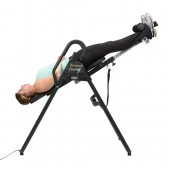A friend of mine has chronic back pain. She has been
taking medications, and has been prescribed specific exercises for the back so
as to keep the pain bearable. I feel really bad about her condition that
worsens at every instance of extra activity. On occasions such as social
gatherings etc., instead of enjoying her time, she is always worried that her
pain might come back unexpectatly. And,
mind you, she is only 32!
I recently came across inversion tables, through
another friend who cannot stop praising of the benefits of inversion tables. I am
planning on suggesting inversion therapy to my friend. But before recommending
her, I might first checkout what inversion therapy is, and if it really helps.
Here is a summary of my research.
To start with, inversion therapy involves inverting
the body upside down, at certain angles. This is very safe to do so, with inversion
tables. An inversion table is a piece of equipment with comfortable backrests and ankle
holders that hold you securely while “inverting”. You need to first adjust the
table according to your height, adjust the angle of inversion, secure your feet
onto the table using straps, and move to the inverted position by pushing the
backrest. Quite easy to perform. Motorized versions of inversion tables are
also available that can invert the table at the push of a button, to the exact
desired angle.
How does inversion therapy work? By hanging upside
down, you let gravity act in an opposite direction. In the upright position,
the discs in your spine are constantly compressed by gravity, leading to
reduced lubrication between discs (just like squeezing out a sponge). This
leads to increased friction between the spinal discs, pinching of nerves,
spinal misalignment, and reduced flexibility of the spine, leading to back pain
at the slightest of spinal movements. Inversion therapy helps in reversing this
effect of gravity. By hanging upside down, the pressure on the spine is
released, and the distance between the vertebrae is increased. This relaxes
your spinal area, and relieves back pain. Experts say that even if you do not
experience back pain, inversion therapy can help you stay fitter and more
flexible. Moreover, inversion therapy is also known to improve blood
circulation. By hanging upside down, blood and lymphs which get pooled at
various points of the body due to the act of gravity (much like the
sedimentation that occurs when muddy water is left to stay still for a while) are
released and moved into the core for oxygenation, filtration, and elimination
of cellular metabolic wastes. Thus, in a way, your body gets detoxified.
These points do make sense to me. I am thinking that
inversion therapy could be a potential solution to my friend’s back problem. I
am confident that this will help to end her misery. In fact, instead of just
advising her about inversion therapy, I am thinking about giving her an
inversion table as a gift. That sounds like a good idea. That’s what I’m gonna
do! However, do keep in mind that inversion therapy is not for everyone. It is
highly recommended to consult a doctor before starting inversion therapy. Inversion
therapy should not be used if you suffer from osteoporosis, glaucoma, heart
disease or high blood pressure, or if you are pregnant. If you know of a friend
or a loved one who suffers from back pain, think about giving him/her an
inversion table, and quite literally, giving him/her good health and a happy,
carefree life!



